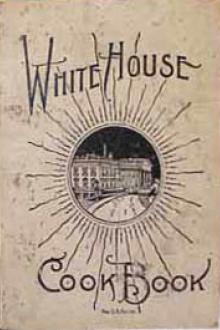The Whitehouse Cookbook (1887), Hugo Ziemann [world of reading .TXT] 📗

- Author: Hugo Ziemann
- Performer: -
Book online «The Whitehouse Cookbook (1887), Hugo Ziemann [world of reading .TXT] 📗». Author Hugo Ziemann
To green pickles, put green grape-vine leaves or green cabbage leaves between them when heating. Another way is to heat them in strong ginger tea. Pickles should be kept closely covered, put into glass jars and sealed tightly.
"Turmeric" is India saffron, and is used very much in pickling as a coloring.
A piece of horse-radish put into a jar of pickles will keep the vinegar from losing its strength, and the pickles will keep sound much longer, especially tomato pickles.
CUCUMBER PICKLES.
Select the medium, small-sized cucumbers. For one bushel make a brine that will bear up an egg; heat it boiling hot and pour it over the cucumbers; let them stand twenty-four hours, then wipe them dry; heat some vinegar boiling hot and pour over them, standing again twenty-four hours. Now change the vinegar, putting on fresh vinegar, adding one quart of brown sugar, a pint of white mustard seed, a small handful of whole cloves, the same of cinnamon sticks, a piece of alum the size of an egg, half a cup of celery seed; heat it all boiling hot and pour over the cucumbers.
SLICED CUCUMBER PICKLE.
Take one gallon of medium-sized cucumbers, put them into a jar or pail. Put into enough boiling water to cover them a small handful of salt, turn it over them and cover closely; repeat this three mornings, and the fourth morning scald enough cider vinegar to cover them, putting into it a piece of alum as large as a walnut, a teacup of horse-radish root cut up fine; then tie up in a small muslin bag, one teaspoonful of mustard, one of ground cloves, and one of cinnamon. Slice up the cucumbers half of an inch thick, place them in glass jars and pour the scalding vinegar over them. Seal tight and they will keep good a year or more.
CUCUMBER PICKLES. (For Winter Use.)
A good way to put down cucumbers, a few at a time:—
When gathered from the vines, wash, and put in a firkin or half barrel layers or cucumbers and rock-salt alternately, enough salt to make sufficient brine to cover them, no water; cover with a cloth; keep them under the brine with a heavy board; take off the cloth, and rinse it every time you put in fresh cucumbers, as a scum will rise and settle upon it. Use plenty of salt and it will keep a year. To prepare pickles for use, soak in hot water, and keep in a warm place until they are fresh enough, then pour spiced vinegar over them and let them stand over night, then pour that off and put on fresh.
GREEN TOMATO PICKLES. (Sweet.)
One peck of green tomatoes, sliced the day before you are ready for pickling, sprinkling them through and through with salt, not too heavily; in the morning drain off the liquor that will drain from them. Have a dozen good-sized onions rather coarsely sliced; take a suitable kettle and put in a layer of the sliced tomatoes, then of onions, and between each layer sprinkle the following spices: Six red peppers chopped coarsely, one cup of sugar, one tablespoonful of ground allspice, one tablespoonful of ground cinnamon, a teaspoonful of cloves, one tablespoonful of mustard. Turn over three pints of good vinegar, or enough to completely cover them; boil until tender. This is a choice recipe.
If the flavor of onions is objectionable, the pickle is equally as good without them.
GREEN TOMATO PICKLES. (Sour.)
Wash and slice, without peeling, one peck of sound green tomatoes, put them into a jar in layers with a slight sprinkling of salt between. This may be done over night; in the morning drain off the liquor that has accumulated. Have two dozen medium-sized onions peeled and sliced, also six red peppers chopped fine. Make some spiced vinegar by boiling for half an hour a quart of cider vinegar with whole spices in it. Now take a porcelain kettle and place in it some of the sliced tomatoes, then some of the sliced onions; shake in some black pepper and some of the chopped red peppers; pour over some of the spiced vinegar; then repeat with the tomatoes, onions, etc., until the kettle is full; cover with cold, pure cider vinegar and cook until tender, but not too soft. Turn into a jar well covered and set in a cool place.
PICKLED MUSHROOMS.
Sufficient vinegar to cover the mushrooms; to each quart of mushrooms two blades pounded mace, one ounce ground pepper, salt to taste. Choose some nice young button mushrooms for pickling and rub off the skin with a piece of flannel and salt, and cut off the stalks; if very large, take out the red inside, and reject the black ones, as they are too old. Put them in a stewpan, sprinkle salt over them, with pounded mace and pepper in the above proportion; shake them well over a clear fire until the liquor flows and keep them there until it is all dried up again; then add as much vinegar as will cover them; just let it simmer for one minute and store it away in stone jars for use. When cold tie down with bladder and keep in a dry place; they will remain good for a length of time, and are generally considered excellent for flavoring stews and other dishes.
PICKLED CABBAGE. (Purple.)
Cut a sound cabbage into quarters, spread it on a large flat platter or dish and sprinkle thickly with salt; set it in a cool place for twenty-four hours; then drain off the brine, wipe it dry and lay it in the sun two hours, and cover with cold vinegar for twelve hours. Prepare a pickle by seasoning enough vinegar to cover the cabbage with equal quantities of mace, allspice, cinnamon and black pepper, a cup of sugar to every gallon of vinegar, and a teaspoonful of celery seed to every pint. Pack the cabbage in a stone jar; boil the vinegar and spices five minutes and pour on hot. Cover and set away in a cool, dry place. It will be good in a month. A few slices of beetroot improves the color.
PICKLED WHITE CABBAGE.
This recipe recommends itself as of a delightful flavor yet easily made, and a convenient substitute for the old-fashioned, tedious method of pickling the same vegetable. Take a peck of quartered cabbage, put a layer of cabbage and one of salt, let it remain over night; in the morning squeeze them and put them on the fire, with four chopped onions covered with vinegar; boil for half an hour, then add one ounce of turmeric, one gill of black pepper, one gill of celery seed, a few cloves, one tablespoonful of allspice, a few pieces of ginger, half an ounce of mace, and two pounds of brown sugar. Let it boil half an hour longer, and when cold it is fit for use. Four tablespoonfuls of made mustard should be added with the other ingredients.
PICKLED CAULIFLOWER.
Break the heads into small pieces and boil ten or fifteen minutes in salt and water; remove from the water and drain carefully. When cold, place in a jar, and pour over it hot vinegar, in which has been scalded a liberal supply of whole cloves, pepper, allspice and white mustard. Tie the spices in a bag, and, on removing the vinegar from the fire, stir into each quart of it two teaspoonfuls of French mustard, and half a cup of white sugar. Cover tightly and be sure to have the vinegar cover the pickle.
PICKLED GREEN PEPPERS.
Take two dozen large, green, bell peppers, extract the seeds by cutting a slit in the side (so as to leave them whole). Make a strong brine and pour over them; let them stand twenty-four hours. Take them out of the brine, and soak them in water for a day and a night; now turn off this water and scald some vinegar, in which put a small piece of alum, and pour over them, letting them stand three days. Prepare a stuffing of two hard heads of white cabbage, chopped fine, seasoned slightly with salt and a cup of white mustard seed; mix it well and stuff the peppers hard and full; stitch up, place them in a stone jar, and pour over spiced vinegar scalding hot. Cover tightly.
GREEN PEPPER MANGOES.
Select firm, sound, green peppers, and add a few red ones as they are ornamental and look well upon the table. With a sharp knife remove the top, take out the seed, soak over night in salt water, then fill with chopped cabbage and green tomatoes, seasoned with salt, mustard seed and ground cloves. Sew on the top. Boil vinegar sufficient to cover them, with a cup of brown sugar, and pour over the mangoes. Do this three mornings, then seal.
CHOWCHOW. (Superior English Recipe.)
This excellent pickle is seldom made at home, as we can get the imported article so much better than it can be made from the usual recipes. This we vouch for being as near the genuine article as can be made: One quart of young, tiny cucumbers, not over two inches long, two quarts of very small white onions, two quarts of tender string beans, each one cut in halves, three quarts of green tomatoes, sliced and chopped very coarsely, two fresh heads of cauliflower, cut into small pieces, or two heads of white, hard cabbage.
After preparing these articles, put them in a stone jar, mix them together, sprinkling salt between them sparingly. Let them stand twenty-four hours, then drain off all the brine that has accumulated. Now put these vegetables in a preserving kettle over the fire, sprinkling through them an ounce of turmeric for coloring, six red peppers, chopped coarsely, four tablespoonfuls of mustard seed, two of celery seed, two of whole allspice, two of whole cloves, a coffee cup of sugar, and two-thirds of a teacup of best ground mixed mustard. Pour on enough of the best cider vinegar to cover the whole well; cover tightly and simmer all well until it is cooked all through and seems tender, watching and stirring it often. Put in bottles or glass jars. It grows better as it grows older, especially if sealed when hot.
PICKLED ONIONS.
Peel small onions until they are white. Scald them in salt and water until tender, then take them up, put them into wide-mouthed bottles, and pour over them hot spiced vinegar; when cold cork them close. Keep in a dry, dark place. A tablespoonful of sweet oil may be put in the bottles before the cork. The best sort of onions for pickling are the small white buttons.
PICKLED MANGOES.
Let the mangoes, or young musk-melons, lie in salt water, strong enough to bear an egg, for two weeks; then soak them in pure water for two days, changing the water two or three times; then remove the seeds and put the mangoes in a kettle, first a layer of grape leaves, then mangoes, and so on until all are in, covering the top with leaves; add a lump of alum the size of a hickory nut; pour vinegar over them and boil them ten





Comments (0)